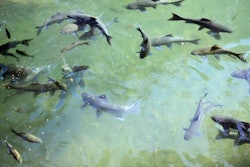
With outbreaks in wild and farmed fish already reported on three continents, the United Nations’ Food and Agriculture Organization (FAO) has issued a “Special Alert” warning that tilapia lake virus (TiLV) should be “treated with concern.” While the disease does not directly affect human health, it poses a significant threat to commercial and food security worldwide.
FAO reports that tilapia species are the second most important aquaculture species in terms of global production, and wild stocks are caught through fishing. As a result, tilapia offer nutritious protein, employment and domestic and export earnings potential for millions of people, many of them in developing countries.
World tilapia production in 2015 was 6.4 million metric tons with a value of US$9.8 billion, with worldwide trade worth an estimated US$1.8 billion, according to FAO. Leading the world rankings in tilapia are China, Indonesia and Egypt, and the fish have potential for expansion in sub-Saharan Africa. The species is relatively inexpensive and easy to culture, being omnivorous, tolerant of intensive farming, and generally resistant to disease.
What is TiLV?
While knowledge of the TiLV is not complete, it has been identified as a member of the same family as salmon anemia virus, which has greatly disrupted the salmon farming industry worldwide.
The disease is highly contagious, and the virus is known to have caused mortality of up to 90 percent of tilapia stocks in some outbreaks in Thailand. Symptoms are non-specific, including loss of appetite, slow swimming, skin lesions, and eye disorders.
A fact sheet on TiLV has been published by CGIAR, a global research partnership for future food security.
Control of TiLV
With the disease already confirmed in five countries – Colombia, Ecuador, Egypt, Israel, and Thailand –FAO is urging countries importing tilapia to take risk management measures. A diagnostic test for TiLV is available, and its use should be intensified, along with the enforcement of health certificates, quarantine, and development of contingency plans, according to FAO’s Global Information and Early Warning System (GIEWS).
The agency is recommending countries launch public information campaigns to inform tilapia farmers, including smallholders, about signs of TiLV and urges them to contact the authorities in case of large-scale mortalities.
TiLV is likely to be more widely distributed than is known, according to FAO. Active surveillance is already being undertaken in China, India and Indonesia, and it is due to be extended to the Philippines.
With many gaps in knowledge of TiLV, research programs are looking into, among other areas, the involvement of other species and frozen tilapia products in the transmission of the virus.
















